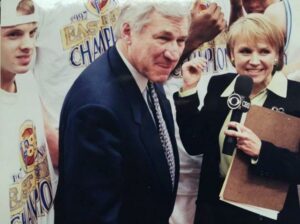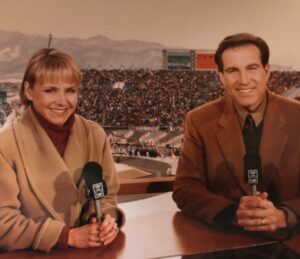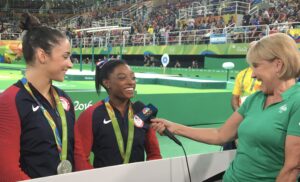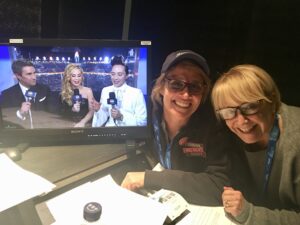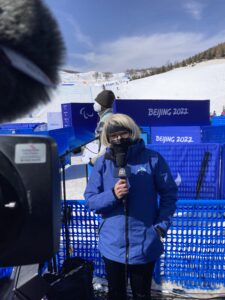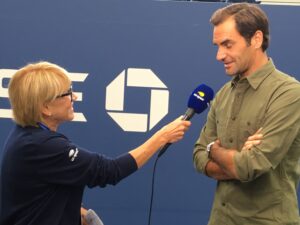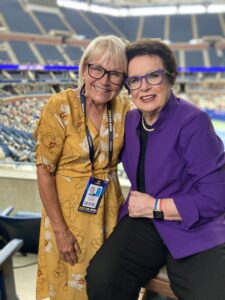Andrea Joyce
On-Air Talent
Year Inducted: 2023
In any individual’s career, there is a specific and poignant moment that stands out from the rest. For Sports Broadcasting Hall of Famer Andrea Joyce, there were a handful of instances that turned the native of Dearborn Heights, MI into the standard bearer of on-air Olympics coverage and real-time reporting.
Some moments occurred as a fan of sports during her formative years living in this suburb of Detroit. Living with three siblings — including two brothers involved in various sports — a loving mother, and a father who survived the Battles of Guadalcanal and Iwo Jima in World War II and declined a football scholarship to Michigan State to help his own father with his corner store, Joyce learned discipline and the value of hard work at a young age. Outside of shaping her work ethic, Joyce’s earliest sports memories featured her father, uncle, and brothers going to Tiger Stadium to see the Detroit Lions every Thanksgiving. One of her most enjoyable was the entire family heading to that same venue to watch the Al Kaline-led Tigers in a historic game on Sept. 17, 1968.
“My father, somehow, got six tickets to that game,” says Joyce. “That was the night that they clinched the pennant and made a trip to the World Series.”
One year later, the Vietnam War was reaching its boiling point in 1969. Back in the States, Joyce was in junior high and positioned at a crossroads with her future. Sifting through the latest edition of the Detroit News, she stumbled on the byline of a female reporter covering the U.S. military’s efforts real time in Vietnam. The piece resonated with her so much that it was the first time she contemplated a career in journalism, and she felt compelled to reach out.
“I wrote her a letter because I thought this was an amazing job that would allow me to travel the world and cover these major events,” says Joyce. “Her mother wrote back to me and said that she couldn’t respond since she was in Vietnam, but she would get back to me when she returned, and she actually did.”
In his final season at North Carolina, Joyce interviewed Dean Smith after advancing to the 1997 NCAA Men’s Basketball Final Four.
With the eventual blaze that was her love for journalism starting out as kindling, she set her sights on finding a university to refine her skills. Despite her father garnering the attention of the Spartans, the family were avid fans of the maize and blue of the University of Michigan Wolverines, which ultimately led her to enroll in the institution in the early 1970s. At the time, the option wasn’t available to Joyce when she first stepped on campus. Tapping into an attribute that would turn her into one of the best sports reporters in the business, her knack for making the best out of any situation led her to taking production courses within the Television, Radio, and Film department. Although she had a relative idea of what she wanted her career to be, she had her reservations after spending four years in Ann Arbor, MI.
“Sitting at the smaller graduation for our department, I didn’t know what I was going to do, but then I heard my name being announced for winning a scholarship for grad school,” she adds. “I became a teaching assistant, but didn’t feel like I was moving forward because I didn’t want to be an academic. I realized that I always directed in my production classes since no one asked for me to talent, so I thought the one thing that I didn’t do was be in front of the camera.”
Recruiting the help of friends, Joyce recorded a demo reel of a weather segment that she would send to stations — big and small — around the nation. Opting for a gig at KKTV in Colorado Springs, CO as their main weather girl over three job offers in Northern Michigan, she packed her bags and headed west to begin the first chapter of her illustrious professional career. Her travels took her from the mountains of Colorado Springs to KTVH-TV in the plains of Wichita, KS and back home to Detroit’s NBC affiliate, WDIV-TV. There, she was bit by the sports journalism bug through reporting human interests stories that surrounded local sports. Through a friendship with University of Michigan football play-by-play announcer Jim Brandstatter, she formed a rapport with legendary head coach Bo Schembechler. After a brief time in Denver to work for KMGH-TV, where she met her husband and news reporter Harry Smith, her most transformative place of employment at the time was as a weekend sports anchor at WFAA-TV in Dallas. Prior to receiving the full-time job, Joyce displayed her first example of resourcefulness. Under the guidance of news director Marty Haag, he deviated from the traditional setup of sports departments with former male players by inserting Joyce into one of those circumstances that would change the course of her story.
“They were short staffed, so they asked if I could go to Reunion Arena and do a live report for the Dallas Mavericks vs. the Denver Nuggets before coming back to do the 10 p.m. show,” continues Joyce. “They historically were unable to get [Nuggets Head Coach] Doug Moe for an interview, but I met him while I was out in Denver and thought maybe he’d remember me. They told me to not waste my time, but I went back to my desk to find out where they team was staying. I called the hotel, the receptionist put me through to Doug’s room, and I was able to schedule an interview at the arena. [The receptionist] changed the trajectory of my life, because if she didn’t put me through, I don’t know if everything would’ve turned out the way it did.”
Joyce spoke with Team USA gymnasts Aly Raisman and Simone Biles at the 2016 Summer Olympics in Rio de Janeiro.
With a bit of ingenuity and dedication, the luck seemed to follow Joyce at every stop along the way. After accepting the full-time job in Dallas, fellow sports anchor and long-time Dallas icon Dale Hansen forged another moment that would give Joyce the confidence to sustain her status as one of the few female reporters in the industry.
“My first big assignment was covering Dallas Cowboys training camp in Thousand Oaks, CA,” adds Joyce. “He was the head of the sports department, so when he went during the first week, I figured all of the big names would have already been interviewed by him. When I got there on the second week, the team’s biggest stars were still available because he saved them for me.”
Her success in the Lone Star State helped gain the interest of ESPN in 1988. She offered her expertise on tentpole events like the NFL Draft and the French Open, but her first taste of the Olympics came during the 1988 Summer Games in Seoul. As a non-rightsholders, ESPN didn’t receive access to players before or after their events. Joyce’s persistence shined once again to capture a much-needed interview.
“I remember seeing in a newspaper that [German tennis player] Steffi Graf was going to be signing autographs, so if we wanted to talk to her, we needed to go there,” says Joyce. “We stood in line with a camera and a microphone, and that’s how I did my job. We had to figure out a way to make it work when you don’t [have all of the access].”
While the public wasn’t always on board with a woman doing local sports, Joyce received tremendous support from many of her colleagues. Hansen was one of them, but when she made her permanent move to a national network like CBS Sports in 1989, she found others there as well to lend critical support.
“Back in New York, our producers wanted one of the guys on our team to interview [Syracuse Men’s Basketball Head Coach] Jim Boeheim, but [Sports Broadcasting Hall of Famer] Lance Barrow insisted that it was my halftime show and I should do the interview,” continues Joyce. “I’ll never forget how adament he was when he went to bat for me. Those are the kind of memories that shine brighter than any negative ones.”
In an effort to push her outside of her comfort zone, CBS Sports’ Executive Producer Ted Shaker paired Joyce with Sports Broadcasting Hall of Famer Mary Carillo to do play-by-play during the 1989 US Open.
“Look at all of the distinguished members of this industry, and then try to find someone who has a better and healthier sense of it all than Andrea Joyce,” says Carillo. “For decades, she has shown us how it can be done — with professionalism, grace, humor, and heart.”
This opportunity led to Joyce being involved on numerous properties during her decade-long tenure at the network, including host duties for early rounds of the 1991 NCAA Division I Men’s Basketball Championship, College Football Today with Mike Francesa, the NCAA Division I Women’s Basketball Championship Final Four and title game from 1991 to 1994; the 1990 Heisman Trophy Award show, the 1990 NBA Playoffs, figure skating, and more.
“We wanted our crew of hosts, play-by-play, and analysts, as well as the men and women in the truck and in the studio, to reflect who our audience was,” says Shaker. “This is almost forty years ago, which was before other broadcasters were doing what CBS Sports was doing to build diversity.”
With diversity in mind, Joyce had the honor of working alongside fellow trailblazer and Sports Broadcasting Hall of Famer Lesley Visser.
“Andrea has always been such a joy – a woman of talent and wit and legendary kindness,” says Visser. “With friends across the industry for decades, and a mentor to those coming along, Andrea’s been the prototype for how to succeed, with optimism, self-assurance and a smile.”
A move to NBC Sports at the turn of the century in 2000 also meant a shift to her current and most prominent role at the network: reporter on the network’s coverage of the Winter and Summer Olympics. Playing a role in the last 12 Olympic Games at NBC Sports, she was also a part of three Olympics at CBS Sports: 1992 in Albertville, France; 1994 in Lillehammer, Norway; and 1998 in Nagano, Japan. Since her first one in 1988, Joyce has embraced the communal nature of the Games that brings countries of the world together. This sentiment was seen many times in front of the camera, but the one that’s stood with Joyce years later occurred off screen in Lillehammer.
“We were off one night after the huge cross-country relay where Norway was supposed to win, but they lost by a nose of a ski to the Italians,” says Joyce. “We were out to dinner at a restaurant and the Italian team walks in. All of the locals [in the restaurant] stood up, and there was silence for a couple of second, but they gave the Italians a standing ovation. That, in a nutshell, tells you everything you need to know about the Olympics.”
An appreciation for sports, the tactfulness to comprehend others’ situations, and ability to grab the story without being inconsiderate or disrespectful has carried Joyce to the
pinnacle of her profession. Gaining these traits from her upbringing and fine-tuning them throughout her storied career, she also obtained knowledge from other female reporters that came before her, including Visser and Sports Broadcasting Hall of Famer Phyllis George.
“None of us would be where we are without women like Lesley and Phyllis beating down the door,” says Joyce. “I’m proud to be a woman who went out there, did her job, and showed that if you do your homework, you’re a hard worker, and you’re honest, you can do it, too.”
Joyce is most proud of the relationships she’s made along the way, particularly with other women in the industry. She calls them her “posse”, which includes women like Billie Jean King, NFL on CBS director Suzanne Smith, NBC Olympics’ Executive Producer & President Molly Solomon, Carillo, Visser, and more. Their example has pushed her to encourage others to pay it forward.
“The most important thing is that, as women in this business, we have always lifted each other up,” says Joyce. “Since I wasn’t an athlete, it’s been a joy for me to be on this amazing world class team.”

